Late Quaternary Segment Faulting Behavior of Yilan-Yitong Fault and Its Potential Seismic Hazards, NE China, by Using Multisource Remote Sensing Data
Highlights
- We identified a ~150 km-long surface rupture with an estimated magnitude of about Mw 7.6 along the Tanlu Fault in Northeast China.
- The time range of the latest paleo-earthquake event determined by multiple new trenches is longer than 2000 years for the newly identified rupture.
- Expands the traditional view of the history of the Tanlu Fault’s segmented faulting since the Holocene.
- Be aware of the urgency of strong earthquakes that may be triggered via Coulomb stress triggering of far-field repeated great earthquakes in weak tectonic activity areas.
Abstract
1. Introduction
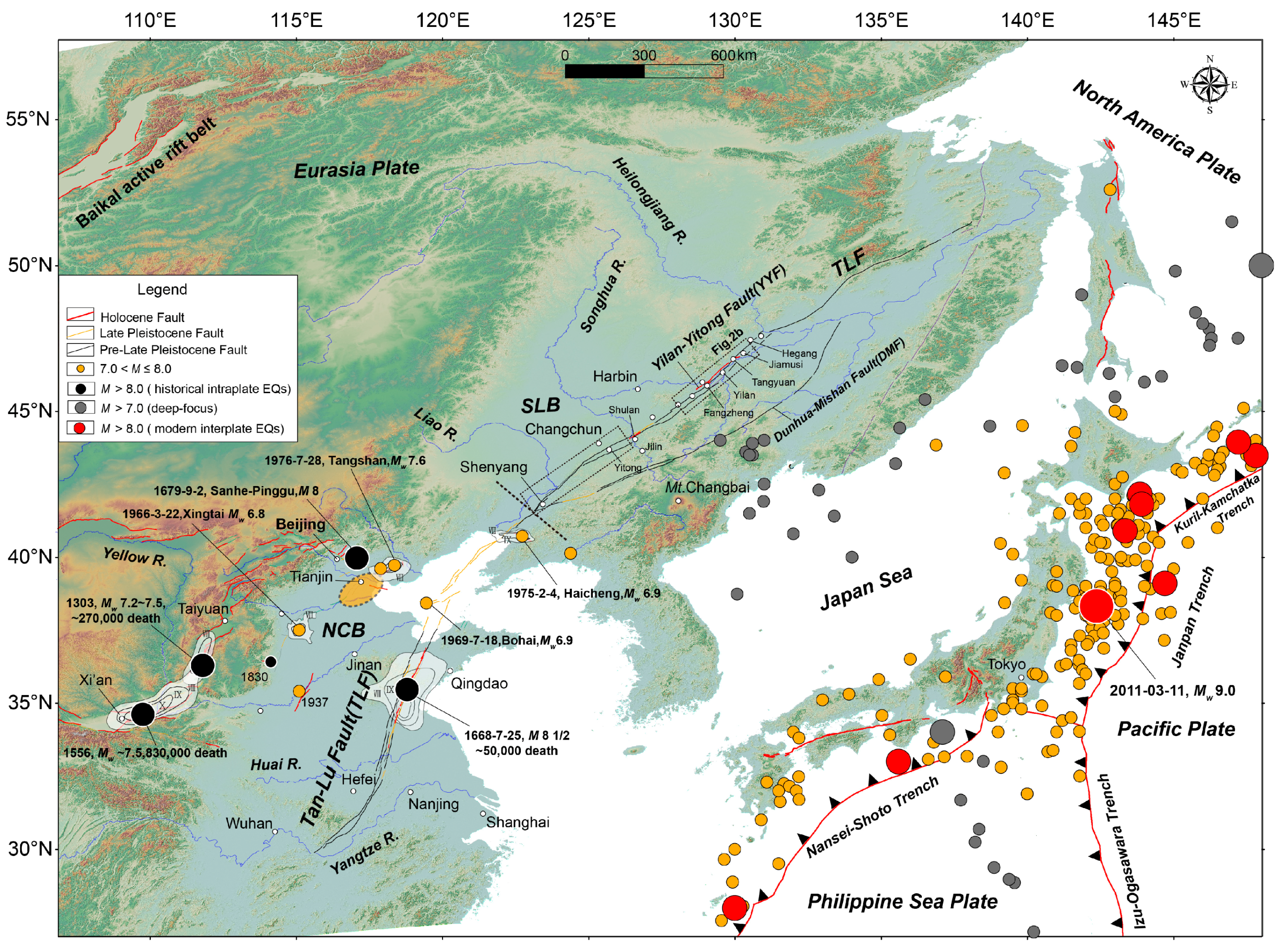
2. Geological Setting
3. Methods and Data
4. Results
4.1. Remote Sensing Interpretation of Linear Landform Scarps
4.2. Trenches Interpretation
4.2.1. Qinghe Trench (TCQH)
4.2.2. Xibeitun Trench (TCXBT)
4.2.3. Anle Trench (TCAL)
4.2.4. Baile Trench (TCBL) and Baile Trench (TCBL)
5. Discussion
5.1. Estimation of the Maximum Magnitude of the Earthquake of YYF
5.2. When Did the Most Recent Event (E1) of YYF Occur?
5.3. Strong Earthquake Hazard Under a Low Slip Rate Background
6. Conclusions
Author Contributions
Funding
Data Availability Statement
Acknowledgments
Conflicts of Interest
References
- Xu, J.; Zhu, G.; Tong, W.; Cui, K.; Liu, Q. Formation and evolution of the Tancheng-Lujiang wrench fault system: A major shear system to the northwest of the Pacific Ocean. Tectonophysics 1987, 134, 273–310. [Google Scholar] [CrossRef]
- Zhang, P.; Min, W.; Deng, Q.; Mao, F. Paleoearthquake rupture behavior and recurrence of great earthquakes along the Haiyuan fault, northwestern China. Sci. China Ser. D 2005, 48, 364–375. [Google Scholar] [CrossRef]
- Xu, X.; Wen, X.; Yu, G.; Chen, G.; Klinger, Y.; Hubbard, J.; Shaw, J. Co-seismic reverse- and oblique-slip surface faulting generated by the 2008 MW 7.9 Wenchuan earthquake, China. Geology 2009, 37, 515–518. [Google Scholar] [CrossRef]
- Wang, X.; Chen, Q.; Niu, F.; Wei, S.; Ning, J.; Li, J.; Wang, W.; Buchen, J.; Liu, L. Distinct slab interfaces imaged within the mantle transition zone. Nat. Geosci. 2020, 13, 822–827. [Google Scholar] [CrossRef]
- Liu-Zeng, J.; Shao, Y.; Klinger, Y.; Xie, K.; Yuan, D.; Lei, Z. Variability in magnitude of paleo-earthquakes revealed by trenching and historical records, along the Haiyuan Fault, China. J. Geophys. Res. Solid Earth 2015, 120, 8304–8333. [Google Scholar] [CrossRef]
- Shao, Z.; Zhan, W.; Zhang, L.; Xu, J. Analysis of the far-field co-seismic and post-seismic responses caused by the 2011 Mw 9.0 Tohoku-Oki Earthquake. Pure Appl. Geophys. 2016, 173, 411–424. [Google Scholar] [CrossRef]
- Shi, X.; Tapponnier, P.; Wang, T.; Wei, S.; Wang, Y.; Wang, X.; Jiao, L. Triple junction kinematics accounts for the 2016 Mw 7.8 Kaikoura earthquake rupture complexity. Proc. Natl. Acad. Sci. USA 2019, 116, 26367–26375. [Google Scholar] [CrossRef]
- Han, Z.; Xu, J.; Ran, Y.; Chen, L.; Yang, X. Active blocks and strong seismic activity in North China region. Sci. China Ser. D Earth Sci. 2003, 46 (Suppl. S2), 153–167. [Google Scholar] [CrossRef]
- Biasi, G.P.; Weldon, R.J. Estimating surface rupture length and magnitude of paleoearthquakes from point measurements of rupture displacement. Bull. Seismol. Soc. Am. 2006, 96, 1612–1623. [Google Scholar] [CrossRef][Green Version]
- Arrowsmith, J.R.; Zielke, O. Tectonic geomorphology of the San Andreas fault zone from high resolution topography: An example from the Cholame segment. Geomorphology 2009, 113, 70–81. [Google Scholar] [CrossRef]
- Zielke, O.; Arrowsmith, J.R.; Ludwig, L.G.; Akciz, S.O. High-resolution topography-derived offsets along the 1857 Fort Tejon earthquake rupture trace, San Andreas fault. Bull. Seismol. Soc. Am. 2012, 102, 1135–1154. [Google Scholar] [CrossRef]
- Zielke, O.; Arrowsmith, J.R.; Ludwig, L.G.; Akciz, S.O. Slip in the 1857 and earlier large earthquakes along the Carrizo Plain, San Andreas fault. Science 2010, 327, 1119–1122. [Google Scholar] [CrossRef] [PubMed]
- Ou, Q.; Kulikova, G.; Yu, J.; Elliott, A.; Parsons, B.; Walker, R. Magnitude of the 1920 Haiyuan earthquake reestimated using seismological and geomorphological methods. J. Geophys. Res. Solid Earth 2020, 125, e2019JB019244. [Google Scholar] [CrossRef]
- Meng, G.; Su, X.; Wu, W.; Nikolay, S.; Takahashi, H.; Ohzono, M.; Gerasimenko, M. Crustal deformation of northeastern China following the 2011 Mw 9.0 Tohoku, Japan earthquake estimated from GPS observations: Strain heterogeneity and seismicity. Remote Sens. 2019, 11, 3029. [Google Scholar] [CrossRef]
- Zhang, Y.; Zheng, W.; Wang, Y.; Zhang, D.; Tian, Y.; Wang, M.; Zhang, Z.; Zhang, P. Contemporary deformation of the North China plain from global positioning system data. Geophys. Res. Lett. 2018, 45, 1851–1859. [Google Scholar] [CrossRef]
- Carboni, F.; Occhipinti, M.; Lanari, R.; Medina, F.; Cherkaoui, T.; Gaspari, R.; Faccenna, F. Strain partitioning and fault interaction during the 2023 Mw 6.8 Al-Haouz earthquake, Western High Atlas, Morocco. J. Struct. Geol. 2025, 195, 105394. [Google Scholar] [CrossRef]
- Molnar, P. The brittle-plastic transition, earthquakes, temperatures, and strain rates. J. Geophys. Res. Solid Earth 2020, 125, e2019JB019335. [Google Scholar] [CrossRef]
- Yin, A.; Yu, X.; Shen, Z.K.; Liu-Zeng, J. A possible seismic gap and high earthquake hazard in the North China Basin. Geology 2015, 43, 19–22. [Google Scholar] [CrossRef]
- Zhang, P.; Deng, Q.; Zhang, G.; Ma, J.; Gan, W.; Min, W.; Mao, F.; Wang, Q. Active tectonic blocks and strong earthquakes in the continent of China. Sci. China Ser. D Earth Sci. 2003, 46 (Suppl. S2), 13–24. [Google Scholar] [CrossRef]
- Min, W.; Jiao, D.C.; Zhou, B.G.; Sheng, J.; Chen, T. The significance of discovery on Holocene activity on the Yilan-Yitong fault in northeast China. Seismol. Geol. 2011, 33, 74–79, (In Chinese with English Abstract). [Google Scholar]
- Min, W.; Liu, Y.; Jiao, D.; Shen, J.; Pan, X. Evidence for Holocene activity of the Yilan-Yitong fault, northeastern section of the Tan-Lu fault zone in Northeast China. J. Asian Earth Sci. 2013, 67, 207–216. [Google Scholar] [CrossRef]
- Yu, Z.; Yin, N.; Shu, P.; Li, J.; Wei, Q.; Min, W.; Zhang, P. Late Quaternary paleoseismicity and seismic potential of the Yilan-Yitong Fault Zone in NE China. J. Asian Earth Sci. 2018, 151, 197–225. [Google Scholar] [CrossRef]
- Yu, Z.; Zhang, P.; Min, W.; Wei, Q.; Liu, Y. Late Holocene slip rate and average recurrence interval of great earthquakes on the Shangzhi segment of the Yilan-Yitong Fault Zone, northeastern China: Constraints from paleo-earthquakes and historical written records. Isl. Arc 2018, 27, e12231. [Google Scholar] [CrossRef]
- Yu, Z.; Yin, N.; Yang, Y.; Li, L.; Ma, Y. Late Quaternary right-lateral slip rate along the Tangyuan segment of the Yilan–Yitong Fault Zone on the NE China Plain. Front. Earth Sci. 2024, 12, 1413084. [Google Scholar] [CrossRef]
- Shu, P.; Min, W.; Liu, Y.; Yu, Z. Tectonic activity and geomorphic features of the Fangzheng section of Yilan-Yitong Fault in the Late Quaternary period. Technol. Earthq. Disaster Prev. 2014, 9, 226–237, (In Chinese with English Abstract). [Google Scholar]
- Shu, P.; Min, W.; Liu, Y.; Xu, X.; Li, K.; Yu, Z.; Yang, H.; Luo, H.; Wei, S.; Fang, L. Late Quaternary paleoseismology and faulting behavior of the Yilan-Yitong fault zone and implications for seismic hazards of the Tanlu fault zone, eastern China. J. Asian Earth Sci. 2020, 201, 104509. [Google Scholar] [CrossRef]
- Wei, Q.; Ha, G.; Min, W.; Zhu, M. Geometry and Kinematics of Northmost Yilan-Yitong Fault Zone, China: Insights from Shallow Seismic Data and Field Investigation. Sustainability 2024, 16, 1943. [Google Scholar] [CrossRef]
- Wang, H.; Liu, M.; Cao, J.; Shen, X.; Zhang, G. Slip rates and seismic moment deficits on major active faults in mainland China. J. Geophys. Res. Solid Earth 2011, 116, B02405. [Google Scholar] [CrossRef]
- Guo, H.; Jiang, W.; Xie, X. Late-Quaternary strong earthquakes on the seismogenic fault of the 1976 Ms7.8 Tangshan earthquake, Hebei, as revealed by drilling and trenching. Sci. China Earth Sci. 2011, 54, 1696–1715. [Google Scholar] [CrossRef]
- Li, Z.; Ni, S.; Roecker, S.; Bao, F.; Wei, X.; Yue, D. Seismic imaging of source region in the 1976 Ms 7.8 Tangshan earthquake sequence and its implications for the seismogenesis of intraplate earthquakes. Bull. Seismol. Soc. Am. 2018, 108, 1302–1313. [Google Scholar] [CrossRef]
- Wang, K.; Chen, Q.F.; Sun, S.; Wang, A. Predicting the 1975 Haicheng earthquake. Bull. Seismol. Soc. Am. 2006, 96, 757–795. [Google Scholar] [CrossRef]
- Xu, M.; Li, Y.; Hou, H.; Wang, C.; Gao, R.; Wang, H.; Han, Z.; Zhou, A. Structural characteristics of the Yilan–Yitong and Dunhua–Mishan faults as northern extensions of the Tancheng–Lujiang Fault Zone: New deep seismic reflection results. Tectonophysics 2017, 706, 35–45. [Google Scholar] [CrossRef]
- Shao, Z.; Wu, Y.; Ji, L.; Diao, F.; Shi, F.; Li, Y.; Long, F.; Zhang, H.; Wang, W.; Wei, W.; et al. Assessment of strong earthquake risk in the Chinese mainland from 2021 to 2030. Earthq. Res. Adv. 2023, 3, 100177. [Google Scholar] [CrossRef]
- Wen, X.; Xu, X.; Long, F.; Xia, C. Frequency-magnitude relationship models for assessment of maximum magnitudes of potential earthquakes on moderately and weakly active faults in eastern China mainland. Seismol. Geol. 2007, 29, 236–253. [Google Scholar]
- Huang, J.; Zhao, D. High-resolution mantle tomography of China and surrounding regions. J. Geophys. Res. Solid Earth 2006, 111, B09305. [Google Scholar] [CrossRef]
- Chen, D.; Zhang, F.; Chen, H.; Dilek, Y.; Yang, S. Structural architecture and tectonic evolution of the Fangzheng sedimentary basin (NE China), and implications for the kinematics of the Tan-Lu fault zone. J. Asian Earth Sci. 2015, 106, 34–48. [Google Scholar] [CrossRef]
- Zhu, G.; Liu, C.; Gu, C.; Zhang, S.; Li, Y.; Su, N.; Xiao, S. Oceanic plate subduction history in the western Pacific Ocean: Constraint from late Mesozoic evolution of the Tan-Lu Fault Zone. Sci. China Earth Sci. 2018, 61, 386–405. [Google Scholar] [CrossRef]
- Li, K.; Xu, X.; Wei, L.; Wang, Q.; Shu, P. Evidence of long recurrence times and low slip rate along the 1668 Tancheng earthquake fault. Chin. Sci. Bull. 2019, 64, 1168–1178. [Google Scholar] [CrossRef]
- Wells, D.L.; Coppersmith, K.J. New empirical relationships among magnitude, rupture length, rupture width, rupture area, and surface displacement. Bull. Seismol. Soc. Am. 1994, 84, 974–1002. [Google Scholar] [CrossRef]
- Leonard, M. Self-consistent earthquake fault-scaling relations: Update and extension to stable continental strike-slip faults. Bull. Seismol. Soc. Am. 2014, 104, 2953–2965. [Google Scholar] [CrossRef]
- Allen, M.B.; Macdonald, D.I.M.; Xun, Z.; Vincent, S.J.; Brouet-Menzies, C. Early Cenozoic two-phase extension and late Cenozoic thermal subsidence and inversion of the Bohai Basin, northern China. Mar. Pet. Geol. 1997, 14, 951–972. [Google Scholar] [CrossRef]
- Gu, C.; Zhu, G.; Zhai, M.; Lin, S.; Song, L.; Liu, B. Features and origin time of Mesozoic strike-slip structures in the Yilan-Yitong Fault Zone. Sci. China Earth Sci. 2016, 59, 2389–2410. [Google Scholar] [CrossRef]
- Chao, H.; Li, J.; Cui, Z.; Zhao, Q. Discussion on several problems related to the seismic fault of the 1668 Tancheng earthquake (M = 8.5). North China Earthq. Sci. 1997, 15, 18–25, (In Chinese with English Abstract). [Google Scholar]
- Wang, H. Holocene slip rate, paleoearthquakes, and recurrence interval of strong earthquakes on the fault where 1668 earthquake M = 8.5 earthquake occurred, Shandong Province. Northwestern Seismol. J. 1995, 17, 206–224, (In Chinese with English Abstract). [Google Scholar]
- Lin, W.; Gao, W. The occurrence intervals of large earthquake in the Yishu fault zone. Earthq. Res. China 1987, 3, 34–40, (In Chinese with English Abstract). [Google Scholar]
- Gao, W.; Li, J.; Li, Q. Geological Map of the Tan-Lu Active Fault Zone (1:50 000), Geological Mapping Group of the Tan-Lu Active Fault Zone; Seismological Press: Beijing, China, 2013. [Google Scholar]
- Wang, M.; Shen, Z. Present-day crustal deformation of continental China derived from GPS and its tectonic implications. J. Geophys. Res. Solid Earth 2020, 125, e2019JB018774. [Google Scholar] [CrossRef]
- Su, Z.; Xu, X.; Liang, S.; Wang, E. Seismotectonics of the 2017–2018 Songyuan Earthquake Sequence, Northeastern China: Passive Bookshelf Faulting and Block Rotation in the Songliao Basin. Seismol. Res. Lett. 2020, 91, 1593–1605. [Google Scholar] [CrossRef]
- McCalpin, J.P. Paleoseismology; Academic Press-Elsevier: New York, NY, USA, 2009; pp. 1–629. [Google Scholar]
- Cao, J.; Ran, Y.; Xu, H. Holocene activity of the Anqiu-Juxian fault on the Jiangsu segment of the Tanlu fault zone and its tectonics implications. Chin. J. Geophys. 2018, 61, 2828–2844, (In Chinese with English Abstract). [Google Scholar]
- Wang, J.; Main, I. Strong historical earthquakes and their relationships with the Tan-Lu fault system and modern seismicity in eastern China. Nat. Hazards 2023, 115, 539–564. [Google Scholar] [CrossRef]
- Gu, G.; Lin, T.; Shi, Z. Catalogue of Chinese Earthquakes (1831 BC–1969 AD); Science Press: Beijing, China, 1983. [Google Scholar]
- Feng, X.; Ma, J.; Zhou, Y.; England, P.; Parsons, B.; Rizza, M.A.; Walker, R.T. Geomorphology and Paleoseismology of the Weinan fault, Shaanxi, central China, and the source of the 1556 Huaxian earthquake. J. Geophys. Res. Solid Earth 2020, 125, e2019JB017848. [Google Scholar] [CrossRef]
- Xu, Y.; He, H.; Deng, Q.; Allen, B.M.; Sun, H.; Bi, L. The CE 1303 Hongdong earthquake and the Huoshan Piedmont Fault, Shanxi Graben: Implications for magnitude limits of normal fault earthquakes. J. Geophys. Res. Solid Earth 2018, 123, 3098–3121. [Google Scholar] [CrossRef]
- Deng, Q.D.; Yu, G.H.; Ye, W.H. Relationship between earthquake magnitude and parameters of surface ruptures associated with historical earthquakes. In Research on Active Fault (2); Seismological Press: Beijing, China, 1993; pp. 247–264, (In Chinese with English Abstract). [Google Scholar]
- Wang, M.; Li, Q.; Wang, F.; Zhang, R.; Wang, Y. Far-field coseismic displacements associated with the 2011 Tohoku-oki earthquake in Japan observed by Global Positioning System. Chin. Sci. Bull. 2011, 56, 2419–2424, (In Chinese with English Abstract). [Google Scholar] [CrossRef]
- Jiang, W.; Zhang, J.; Han, Z.; Tian, T.; Jiao, Q.; Wang, X.; Jiang, H. Characteristic slip of strong earthquakes along the Yishu fault zone in east China evidenced by offset landforms. Tectonics 2017, 36, 1947–1965. [Google Scholar] [CrossRef]
- Uchida, N.; Bürgmann, R. A decade of lessons learned from the 2011 Tohoku-Oki earthquake. Rev. Geophys. 2021, 59, e2020RG000713. [Google Scholar] [CrossRef]
- Usami, K.; Ikehara, K.; Kanamatsu, T.; McHugh, C. Supercycle in great earthquake recurrence along the Japan Trench over the last 4000 years. Geosci. Lett. 2018, 5, 11. [Google Scholar] [CrossRef]
- Heilongjiang Provincial Institute of Cultural Relics and Archaeology. Fenglin City: Archaeological Excavation Report 1998–2000; Science Press: Beijing, China, 2019. (In Chinese) [Google Scholar]
- Xu, W.; Wang, J.; Yin, J. Late Quaternary faulted landforms and recent activity of the eastern segment of the Nanbei River–Boli Fault. J. Struct. Geol. 2024, 183, 105128. [Google Scholar] [CrossRef]
- Klinger, Y.; Etchebes, M.; Tapponnier, P.; Naarteau, C. Characteristic slip for five great earthquakes along the Fuyun fault in China. Nat. Geosci. 2011, 4, 389–392. [Google Scholar] [CrossRef]
- Li, S.; Chen, Q.; Zhao, L.; Zhu, L.; Gao, Z. Anomalous focal mechanism of the May 2011 Mw 5.7 deep earthquake in Northeastern China: Regional waveform inversion and possible mechanism. Chin. J. Geophys. 2013, 56, 2959–2970. [Google Scholar]
- Li, Z. Collision between the North and South China blocks: A crustal-detachment model for suturing in the region east of the Tanlu fault. Geology 1994, 22, 739–742. [Google Scholar] [CrossRef]
- Liu, M.; Yang, Y.; Shen, Z.; Wang, S.; Wang, M.; Wan, Y. Active tectonics and intracontinental earthquakes in China: The kinematics and geodynamics. Geol. Soc. Am. 2007, 42, 299–318. [Google Scholar]
- Liu, T.; Fu, G.; She, Y.; Meng, G.; Zou, Z.; Wu, W.; Shestakov, N.; Gerasimenko, M.; Bykov, V.; Puppatenko, V. Post-seismic deformation following the 2011 Mw9. 0 Tohoku–Oki earthquake and its impact on Northeast Asia. Geophys. J. Int. 2023, 235, 1479–1492. [Google Scholar] [CrossRef]
- Ren, Z.; Zhang, Z.; Chen, T.; Yan, S.; Yin, J.; Zhang, P.; Zheng, W.; Zhang, H.; Li, C. Clustering of offsets on the Haiyuan fault and their relationship to paleoearthquakes. Geol. Soc. Am. Bull. 2016, 128, 3–18. [Google Scholar] [CrossRef]
- Tian, J.; Ye, G.; Ding, Z.; Wu, Q.; Wei, W.; Jin, S.; Xie, C. A study of the deep electrical structure of the northern segment of the Tan-Lu fault zone, NE China. J. Asian Earth Sci. 2019, 170, 118–127. [Google Scholar] [CrossRef]
- Wang, L.; Liu, J.; Zhao, J.; Zhao, J. Coseismic Slip and Post-seismic Relaxation of the 2011 M9.0 Tohoku-oki Earthquake and its Influence on China Mainland. Earthquake 2013, 3, 238–247, (In Chinese with English Abstract). [Google Scholar]
- Yan, S.; Zhou, L.; Yu, S.; Lu, P. A documentary record of earthquake-induced floods and risk assessment in the lower Yellow River during the past 700 years. Holocene 2025, 35, 977–985. [Google Scholar] [CrossRef]
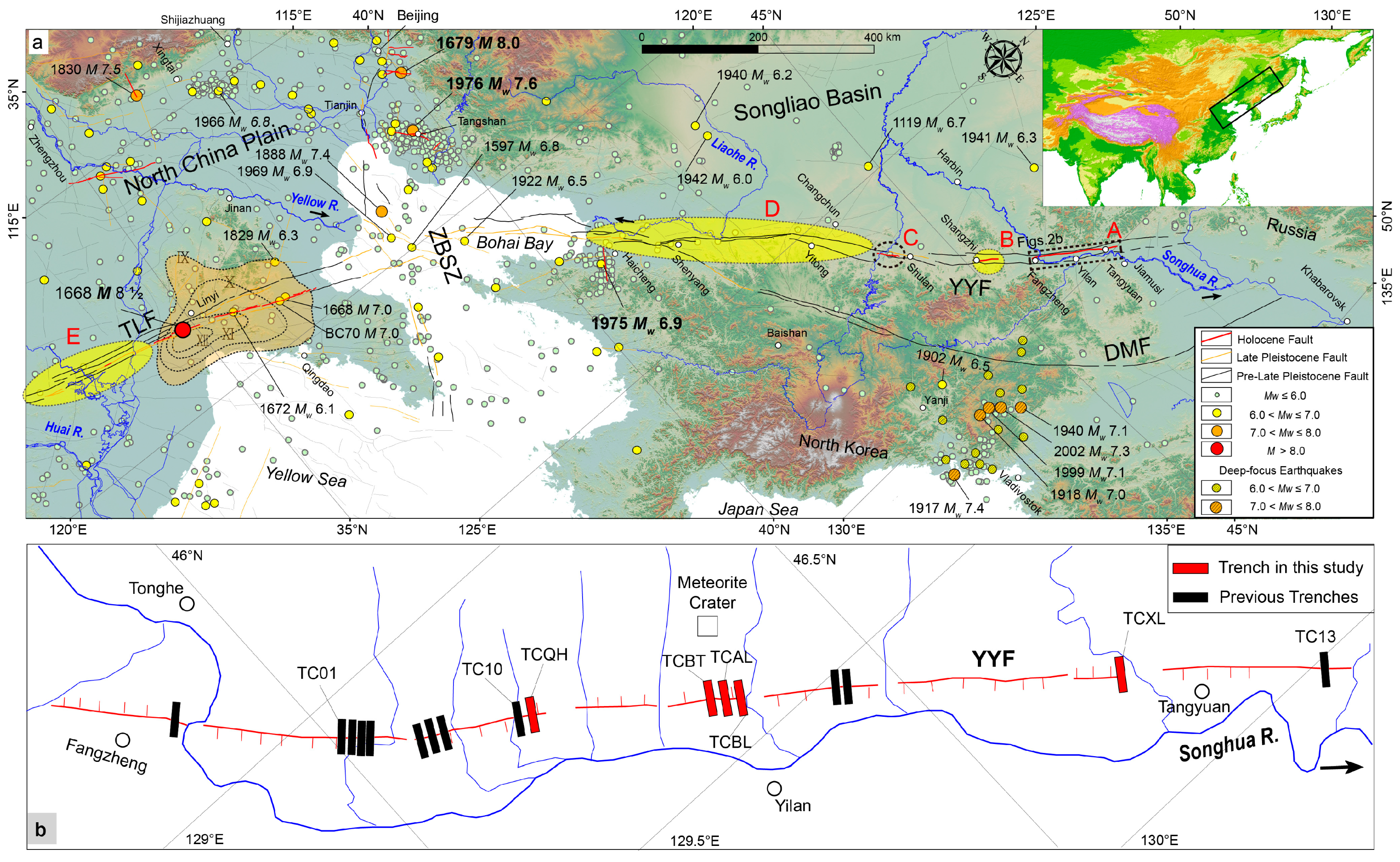
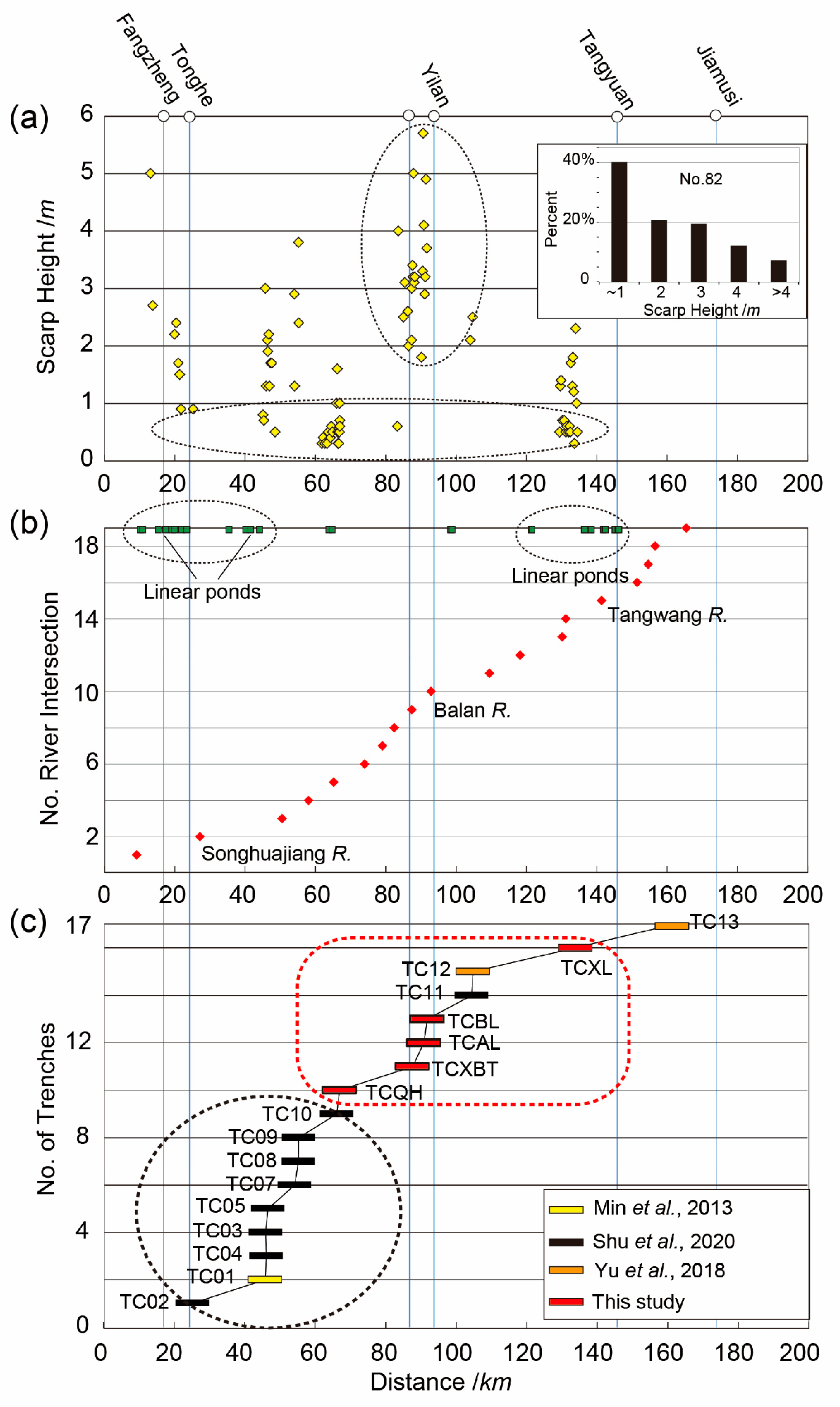
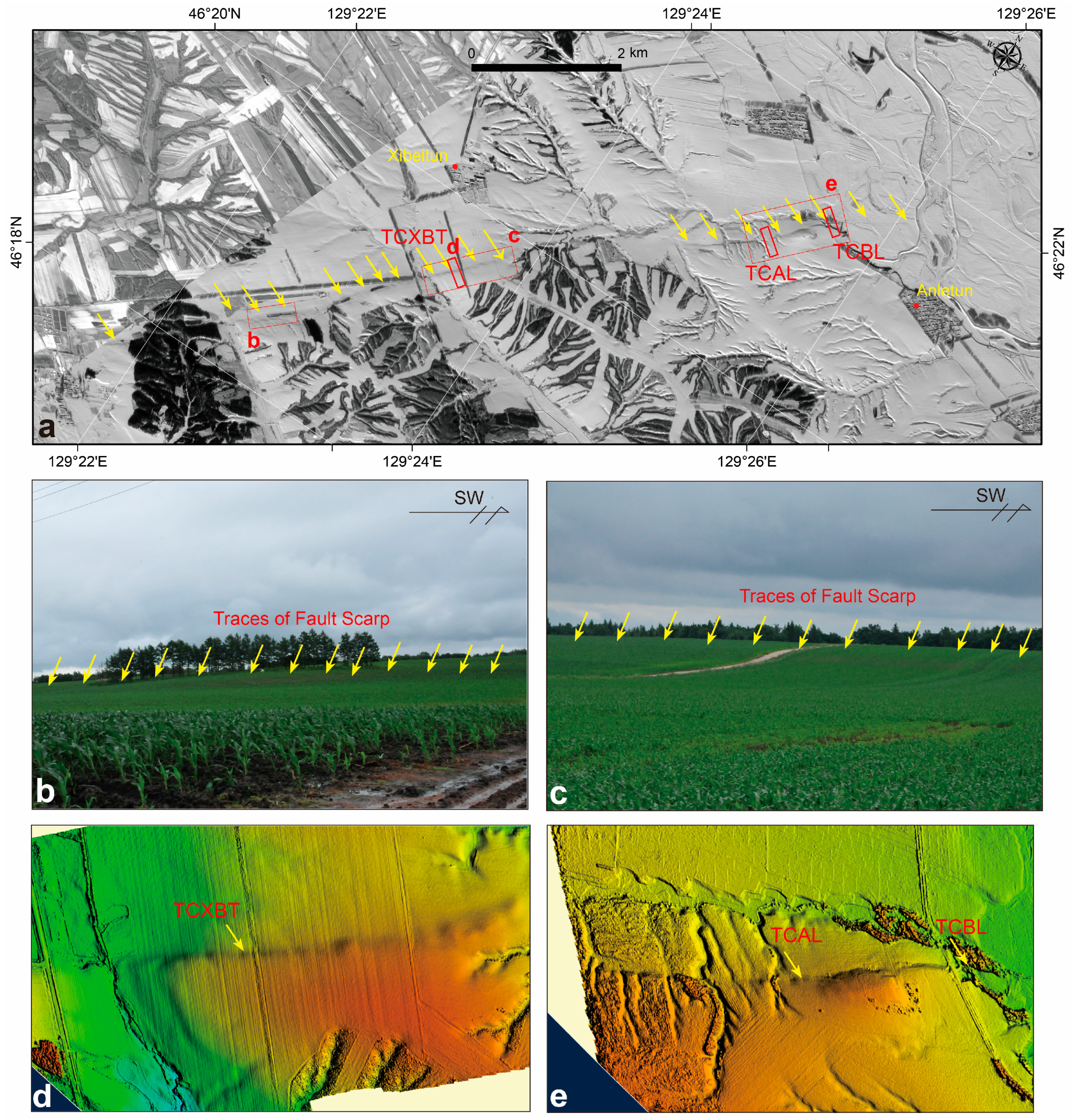

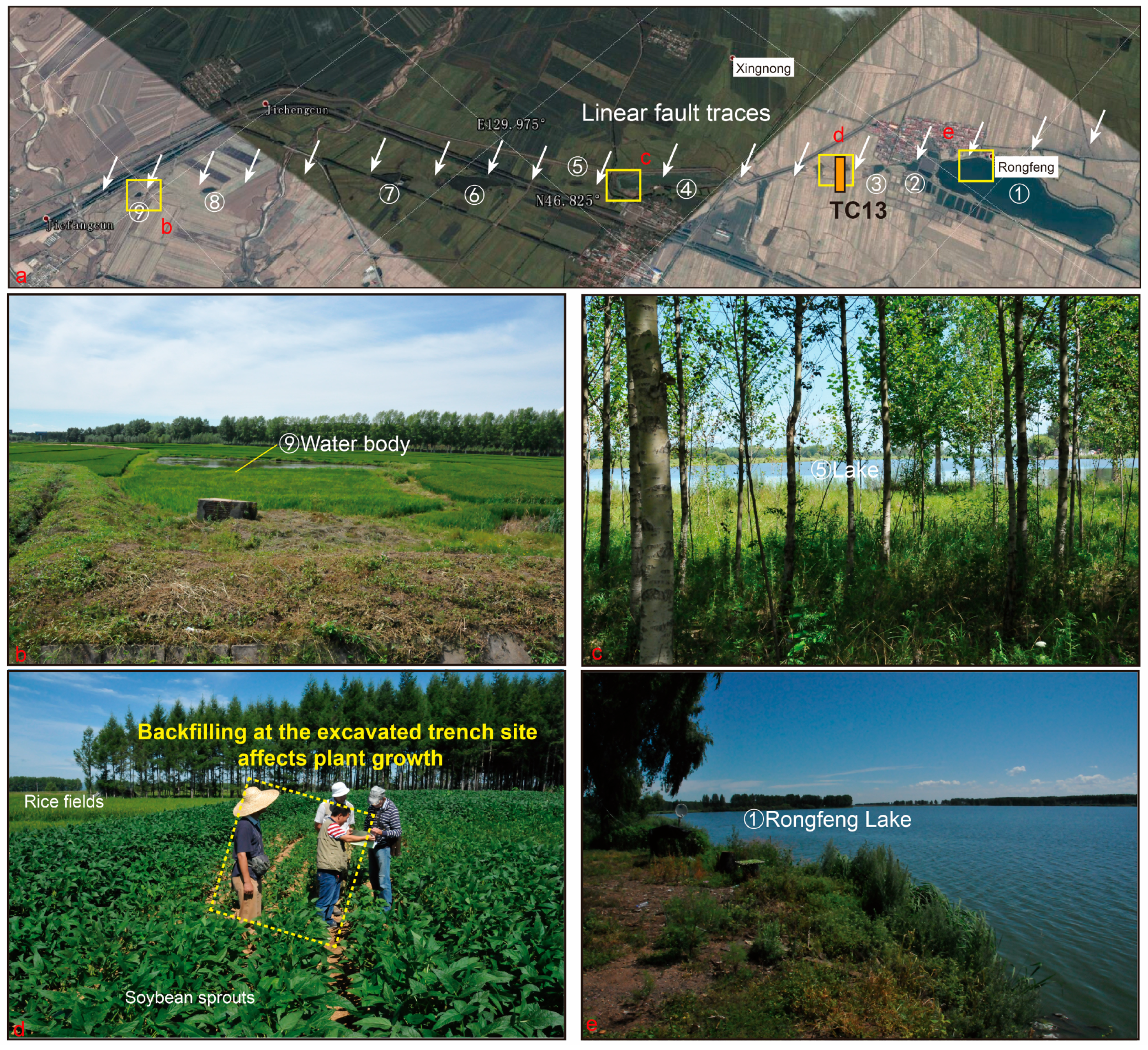
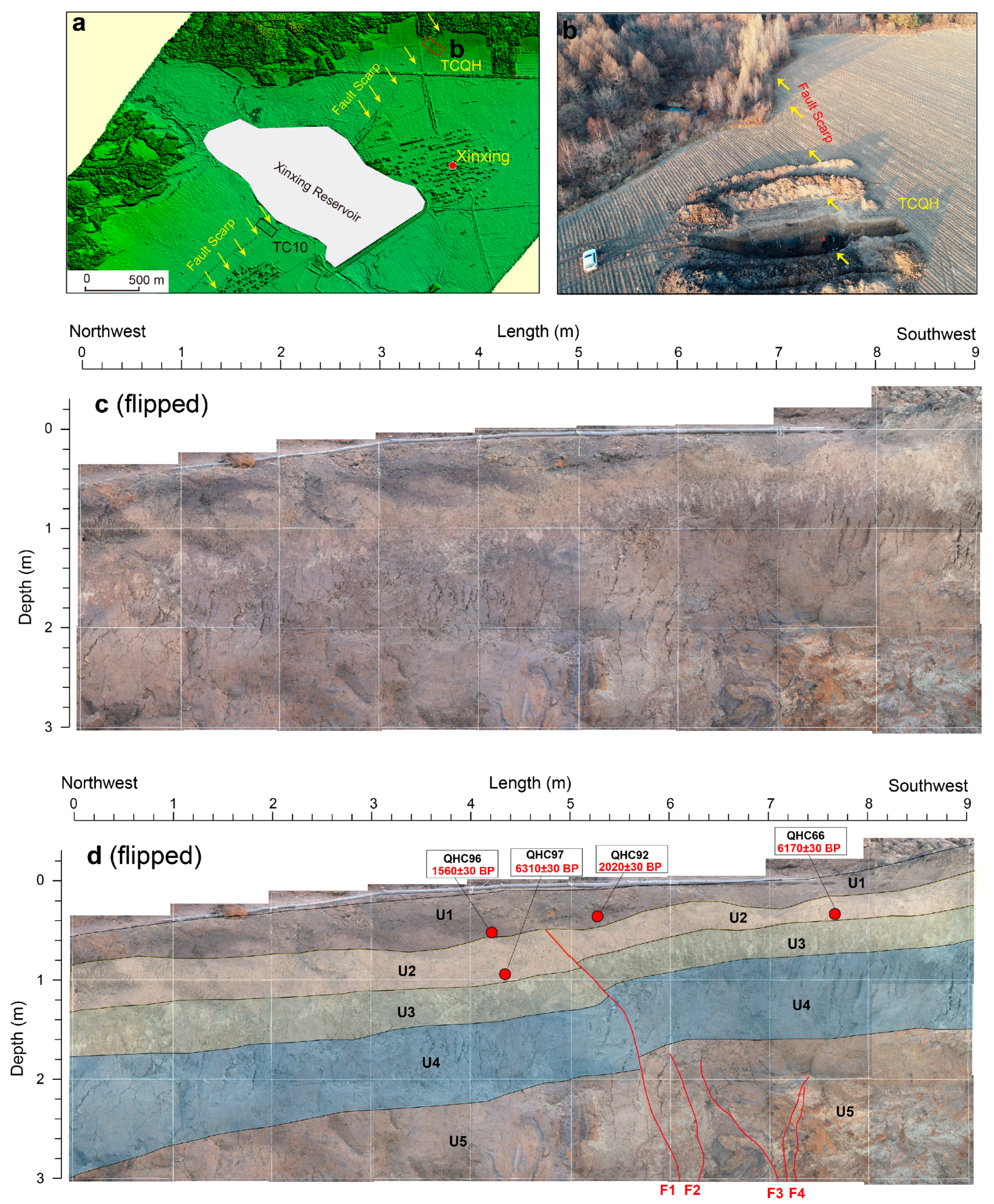
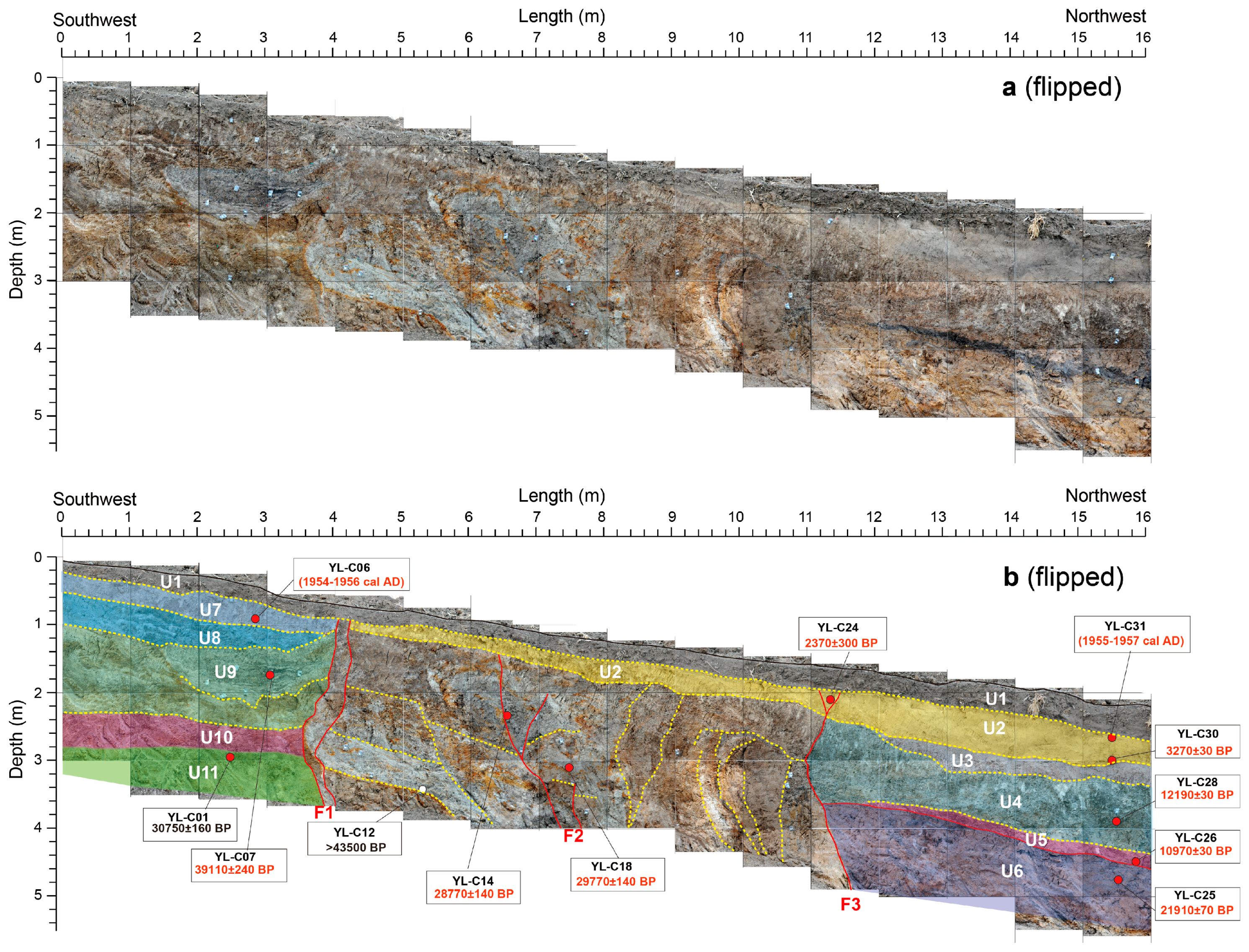
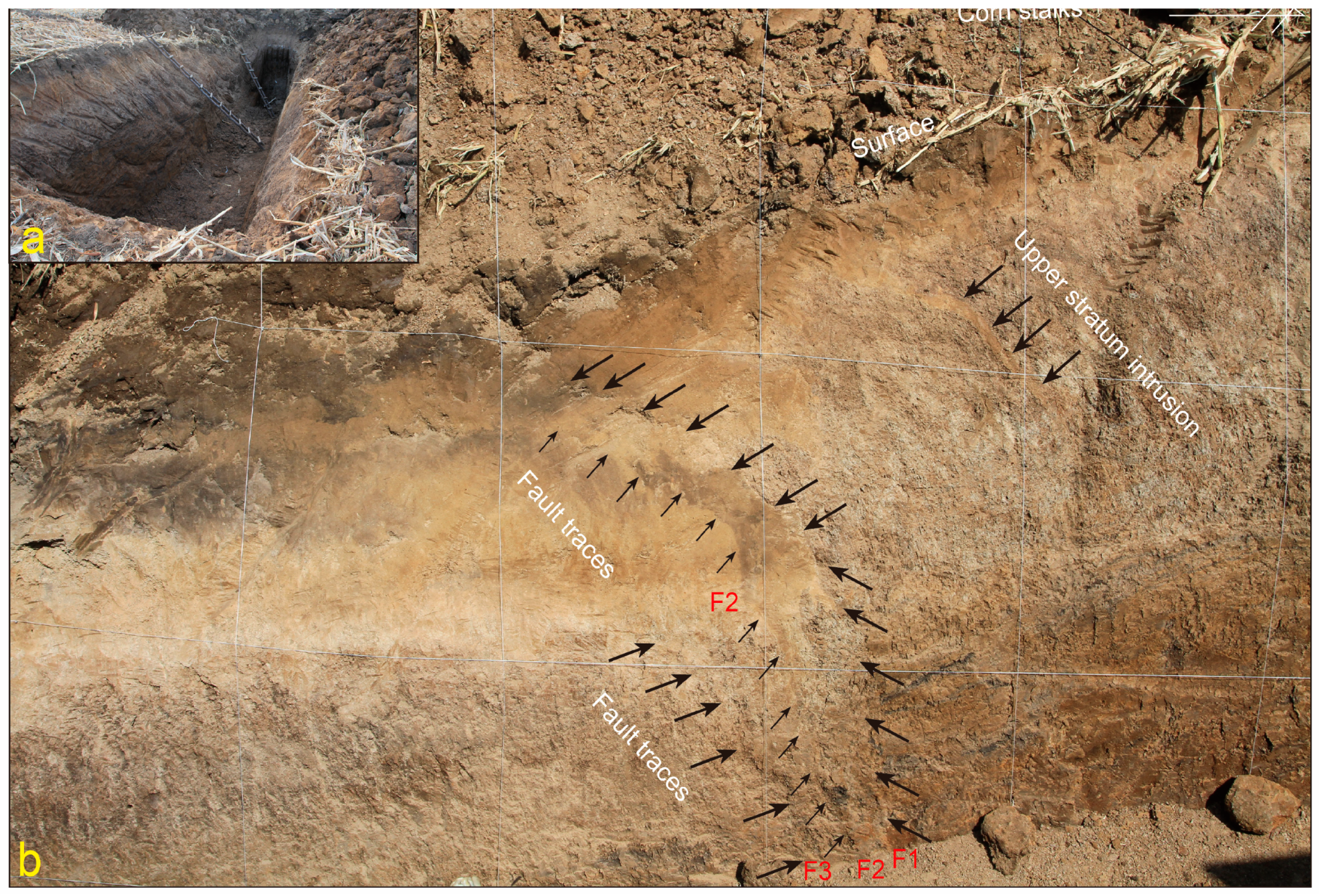
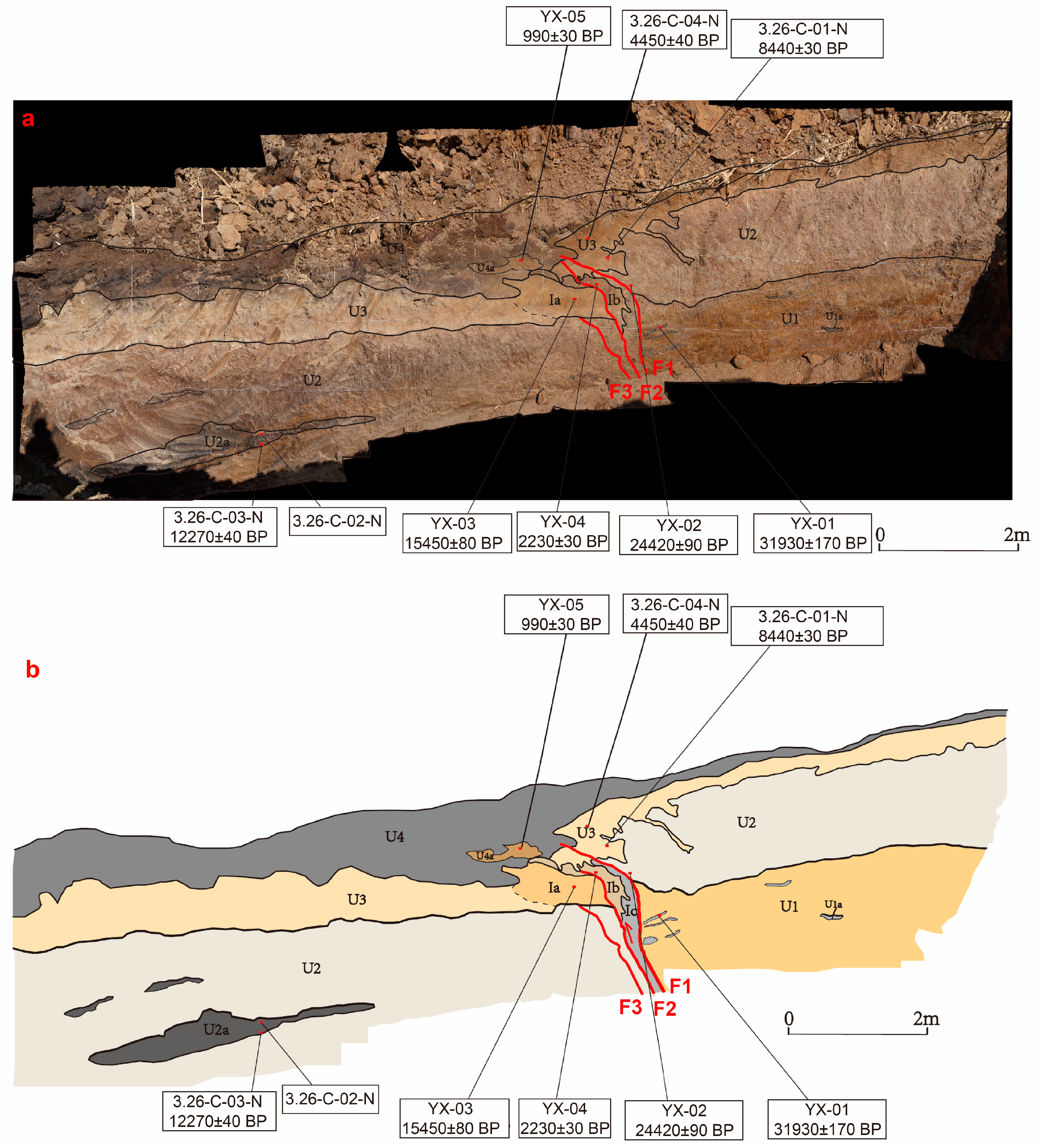

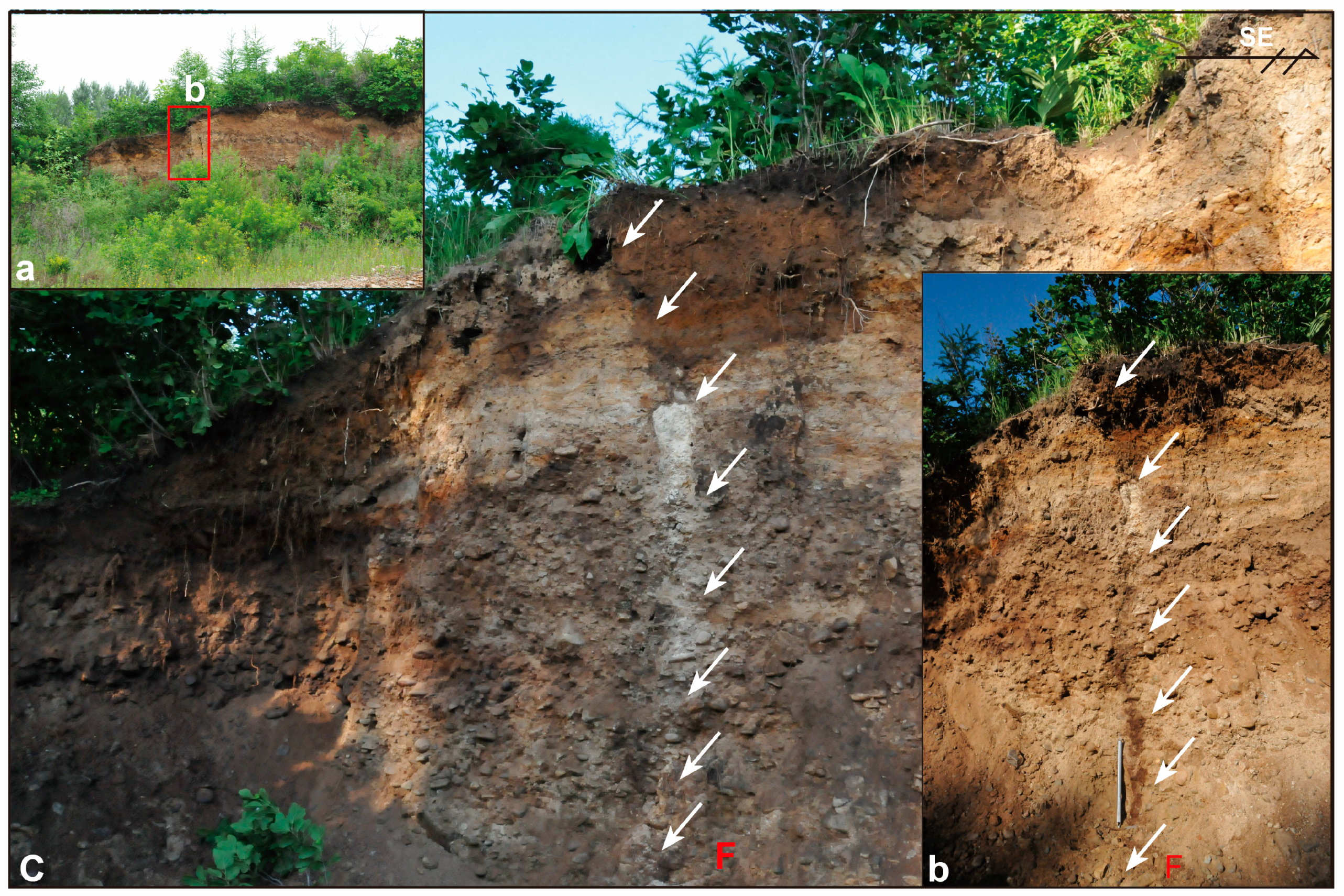
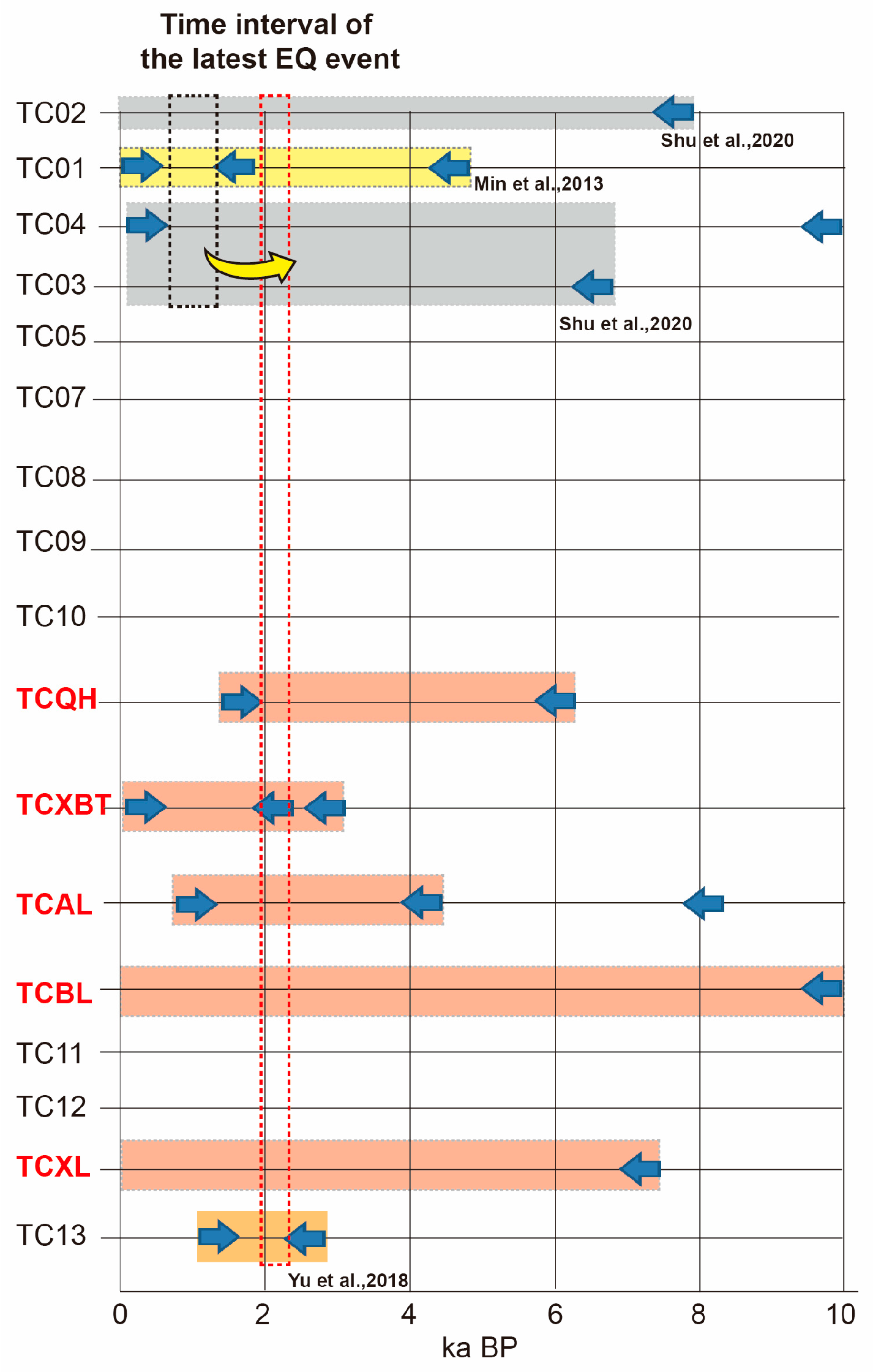
| No. | BETA No. | Field No. | Conventional Age | Calendar Calibration (95.4% Probability) | Material | Report Time | Percent Modern Carbon (pMC) | Sample Sites |
|---|---|---|---|---|---|---|---|---|
| 1 | 537679 | YL-C31 | 103.81 ± 0.39 pMC | 1955–1957 cal AD | charred | 10/17/2019 | 103.81 ± 0.39 | TCXBT |
| 2 | 537678 | YL-C30 | 3270 ± 30 BP | 1623–1496 cal BC (3572–3445 cal BP) | organic sediment | 10/17/2019 | 66.56 ± 0.25 | |
| 3 | 537677 | YL-C28 | 12,190 ± 30 BP | 12,243–12,023 cal BC (14,192–13,972 cal BP) | organic sediment | 10/17/2019 | 21.93 ± 0.08 | |
| 4 | 537676 | YL-C26 | 10,970 ± 30 BP | 10,983–10,769 cal BC (12,932–12,718 cal BP) | organic sediment | 10/17/2019 | 25.52 ± 0.10 | |
| 5 | 537675 | YL-C25 | 21,910 ± 70 BP | 24,381–23,979 cal BC (26,330–25,928 cal BP) | organic sediment | 10/17/2019 | 6.54 ± 0.06 | |
| 6 | 537674 | YL-C24 | 2370 ± 30 BP | 539–388 cal BC (2488–2337 cal BP) | organic sediment | 10/17/2019 | 74.45 ± 0.28 | |
| 7 | 557560 | YL-C18 | 29,770 ± 140 BP | 32,211–31,686 cal BC (34,160–33,635 cal BP) | organic sediment | 5/4/2020 | 2.46 ± 0.04 | |
| 8 | 557559 | YL-C14 | 28,710 ± 130 BP | 31,406–30,371 cal BC (33,355–32,320 cal BP) | organic sediment | 5/4/2020 | 2.80 ± 0.05 | |
| 9 | 557558 | YL-C12 | >43,500 BP | >cal BC 44,650 (cal BP 46,600) | charred | 5/4/2020 | <0.44 | |
| 10 | 557557 | YL-C07 | 39,110 ± 240 BP | 41,361–40,590 cal BC (43,310–42,539 cal BP) | organic sediment | 5/4/2020 | 0.77 ± 0.02 | |
| 11 | 557556 | YL-C06 | 102.14 ± 0.38 pMC | 1954–1956 cal AD | charred | 5/4/2020 | 102.14 ± 0.38 | |
| 12 | 557555 | YL-C01 | 30,750 ± 160 BP | 33,058–32,362 cal BC (35,007–34,311 cal BP) | organic sediment | 5/4/2020 | 2.18 ± 0.04 | |
| 13 | 462787 | 3.26-TC2-C-02 | 24,060 ± 90 BP | 26,440–25,870 cal BC (28,389–27,819 cal BP) | organic sediment | 4/26/2017 | 5.00 ± 0.06 | TCAL |
| 14 | 462786 | 3.26-TC2-C-01 | 10,390 ± 30 BP | 10,456–10,142 cal BC (12,405–12,091 cal BP) | organic sediment | 4/26/2017 | 27.43 ± 0.10 | |
| 15 | 462785 | YX-05 | 990 ± 30 BP | 989–1052 cal AD (961–898 cal BP) | organic sediment | 4/26/2017 | 88.40 ± 0.33 | |
| 16 | 462784 | YX-04 | 2230 ± 30 BP | 328–204 cal BC (2277–2153 cal BP) | charred | 4/26/2017 | 75.76 ± 0.28 | |
| 17 | 462783 | YX-03 | 15,450 ± 80 BP | 16,931–16,599 cal BC (18,880–18,548 cal BP) | charred | 4/26/2017 | 14.61 ± 0.15 | |
| 18 | 462782 | YX-02 | 24,420 ± 90 BP | 26,776–26,254 cal BC (28,725–28,203 cal BP) | organic sediment | 4/26/2017 | 4.78 ± 0.05 | |
| 19 | 462781 | YX-01 | 31,930 ± 170 BP | 34,291–33,471 cal BC (36,240–35,420 cal BP) | organic sediment | 4/26/2017 | 1.88 ± 0.04 | |
| 20 | 462780 | 3.26-C-04 | 25,220 ± 110 BP | 27,632–26,993 cal BC (29,581–28,942 cal BP) | charred | 4/26/2017 | 4.33 ± 0.06 | |
| 21 | 462779 | 3.26-C-03 | 2600 ± 30 BP | 826–763 cal BC (2775–2712 cal BP) | charred | 4/26/2017 | 72.35 ± 0.27 | |
| 22 | 462778 | 3.26-C-02 | 17,130 ± 60 BP | 18,925–18,525 cal BC (20,874–20,474 cal BP) | charred | 4/26/2017 | 11.85 ± 0.09 | |
| 23 | 462777 | 3.26-C-01 | 6150 ± 30 BP | 5210–5009 cal BC (7159–6958 cal BP) | organic sediment | 4/26/2017 | 46.51 ± 0.17 | |
| 24 | 462776 | 3.26-C-04-N | 4450 ± 40 BP | 3196–3007 cal BC (5145–4956 cal BP) | charred | 4/26/2017 | 57.47 ± 0.29 | |
| 25 | 462775 | 3.26-C-03-N | 12,270 ± 40 BP | 12,467–12,078 cal BC (14,416–14,027 cal BP) | organic sediment | 4/26/2017 | 21.71 ± 0.11 | |
| 26 | 462774 | 3.26-C-01-N | 8440 ± 30 BP | 7574–7482 cal BC (9523–9431 cal BP) | organic sediment | 4/26/2017 | 34.97 ± 0.13 | |
| 27 | 555680 | QHC96 | 1560 ± 30 BP | 420–565 cal AD (1530–1385 cal BP) | organic sediment | 4/3/2020 | 82.35 ± 0.31 | TCQH |
| 28 | 555679 | QHC97 | 6310 ± 30 BP | 5346–5218 cal BC (7295–7167 cal BP) | organic sediment | 4/3/2020 | 45.59 ± 0.17 | |
| 29 | 555683 | QHC66 | 6170 ± 30 BP | 5216–5031 cal BC (7165–6980 cal BP) | organic sediment | 4/3/2020 | 46.39 ± 0.17 | |
| 30 | 555681 | QHC92 | 2020 ± 30 BP | 106 cal BC–58 cal AD (2055–1892 cal BP) | organic sediment | 4/3/2020 | 77.77 ± 0.2 |
Disclaimer/Publisher’s Note: The statements, opinions and data contained in all publications are solely those of the individual author(s) and contributor(s) and not of MDPI and/or the editor(s). MDPI and/or the editor(s) disclaim responsibility for any injury to people or property resulting from any ideas, methods, instructions or products referred to in the content. |
© 2025 by the authors. Licensee MDPI, Basel, Switzerland. This article is an open access article distributed under the terms and conditions of the Creative Commons Attribution (CC BY) license (https://creativecommons.org/licenses/by/4.0/).
Share and Cite
Wei, Q.; Liu, S.; Yang, P.; Hu, C.; Li, W.; Du, P.; Kang, J.; Zhang, Y.; Zhang, Z.; Tian, Q.; et al. Late Quaternary Segment Faulting Behavior of Yilan-Yitong Fault and Its Potential Seismic Hazards, NE China, by Using Multisource Remote Sensing Data. Remote Sens. 2025, 17, 3523. https://doi.org/10.3390/rs17213523
Wei Q, Liu S, Yang P, Hu C, Li W, Du P, Kang J, Zhang Y, Zhang Z, Tian Q, et al. Late Quaternary Segment Faulting Behavior of Yilan-Yitong Fault and Its Potential Seismic Hazards, NE China, by Using Multisource Remote Sensing Data. Remote Sensing. 2025; 17(21):3523. https://doi.org/10.3390/rs17213523
Chicago/Turabian StyleWei, Qinghai, Shuang Liu, Panxin Yang, Chaozhong Hu, Wenqiao Li, Peng Du, Jian Kang, Yanbo Zhang, Zhe Zhang, Qinjian Tian, and et al. 2025. "Late Quaternary Segment Faulting Behavior of Yilan-Yitong Fault and Its Potential Seismic Hazards, NE China, by Using Multisource Remote Sensing Data" Remote Sensing 17, no. 21: 3523. https://doi.org/10.3390/rs17213523
APA StyleWei, Q., Liu, S., Yang, P., Hu, C., Li, W., Du, P., Kang, J., Zhang, Y., Zhang, Z., Tian, Q., & Xu, Y. (2025). Late Quaternary Segment Faulting Behavior of Yilan-Yitong Fault and Its Potential Seismic Hazards, NE China, by Using Multisource Remote Sensing Data. Remote Sensing, 17(21), 3523. https://doi.org/10.3390/rs17213523






